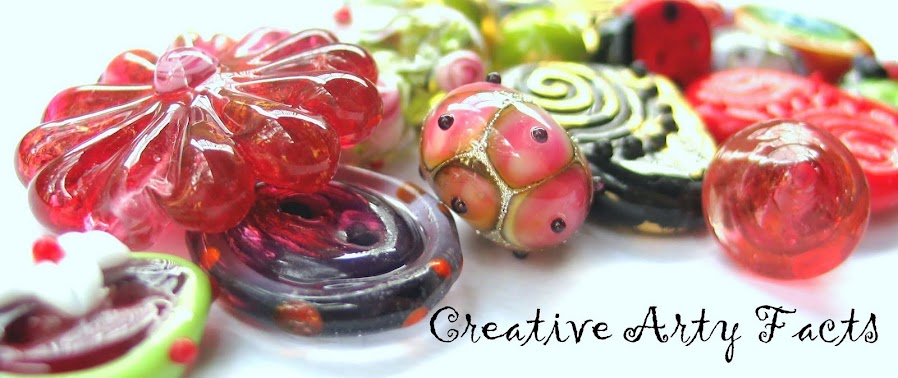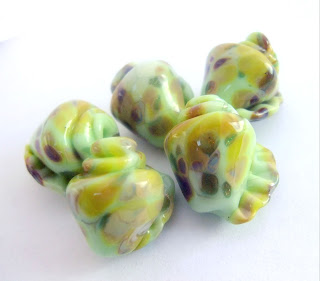Cookie Dough - 511711 Ltd Run
CiM describes this colour as an opaque beige but I found that continuous heating in the flame almost softens this colours to a lovely creamy consistency - a perfect base colour!
It reminds me of a softer, lighter version of Oyster Mushroom (also recently released) but much paler and less intense in colour. The glass was soft and thick but easy to melt in the flame and therefore perfect for pressed or roller shaped beads.
Fiddlehead - 511420 Ltd Run
This soft opaque green glass in one of newest members of the CiM green colour palette and whilst initially very similar to others in this family ( recently released Iguana - 511419 and previously released Split Pea - 511481) is it stable and consistent in colour and shows very little signs of colour striation and separation.
It was the perfect glass to make these headpins, melting easily and perfect in consistency to allow the glass to be manipulated and shade in the flame.
Green Tea - 511421 Ltd Run
This lovely shade of transparent green glass is a nice addition to the CiM green colour palette. I was soft and easy to melt in the flame and was perfect for soft glass sculptural pieces.
These glass headpins were fused directly onto 20G copper wire. This shade of green (almost Peridot) in colour in my opinion is an almost perfect colour match for Effetre Pale emerald. It is not too watery in colour or densely saturated, making it 'just right' and the perfect partner to several opaque CiM greens already in production.
Oyster Mushroom is described as an ivory glass with green hues. I didn't see too much of the green but more beige in colour. In the flame, the glass was soft and easy to melt making it a perfect consistency for any bead maker to use.
These beads were surfaced decorated with a blend of reactive glass frit and silver glass murrini so the glass has since chanced from its initial soft creamy beige appearance to mild mushroom colour - the ideal colour for organic styled beads.
Dried Sage: 511415 Ltd run
This soft green opaque glass has a very soft olive green tint to it in rod form. After working this glass heavily in the flame for some time, I noticed a colour shift from green to ivory. This was further developed after using silvered glass to add decoration to the surface of the bead.
This particular glass was soft and melted easily in the flame and makes a great base for beads that require a solid base.
Dark Velvet: 511610 Ltd run
This dark, almost black transparent glass has a definitive purple base that is very obvious once you thin the glass by pulling stringer. The base of the glass has a black look but in thin parts of the bead (around the bead hole) it is very apparent that the glass has a dense purple foundation. These beads were decorated with large twists of Dark Velvet and Dark Ivory - you can see how purple this glass is in the thin parts of the stringer where the fold was very close to the surface.
Like any other black glass, it is a must "inclusion" for the basic colour palette.
I found this class to be quite lovely to use, despite my initial reaction to the colour! What a wonderful surprise to discover that the glass turned into the most creamy caramel base allowing me to surface decorate the bead with silver frit and silver handmade murrini!
Of all the glass I have tested in this batch, this would have to be my absolute favorite! It reminds me of a rich batch of stone ground ginger from the CiM range and very similar to batches of old Opal yellow from Effetre!
It was soft and easy to melt in the flame. The colour developed from pale yellow through to rich butterscotch caramel from the flame to the kiln.
Mediterranean: 511516 Ltd run
Although very beautiful this, glass was extremely Stiff and quite difficult to use.
This was quite surprising as many transparent glasses Become quite soft and butter like in the flame
It was also quite saturated in colour making it a very Difficult to actually show off its beauty.
Eventually I laid it over an Ivory and silver leaf base, Allowing the Silverleaf to shine through a thin layer
I really love this, but would struggle to use this in my beadmaking routine as it was quite stiff and took considerable time to melt in the flame.
Sherbert: 511417 Ltd run
This soft green based glass is creamy and soft in consistency and melts easily in the flame. I used it to make these sculptural shells and noticed that while the soft was relatively soft in the flame, it did cool quickly.
The initial pale soft colour developed into a medium shade of opaque green glass - making it sit somewhere between CiM Cardamom and Key Lime Pie. It remained quite stable from flame to kiln and had little noted change from using the reactive 96 glass frit as surface decoration.
Breeze -511517 Ltd Run
This
is a gorgeous shade of transparent aqua blue glass. Like many of the
transparent CiM colours that are quite dense in colour, I thought that
this too would be too dark for my work. I was pleasantly surprised at
how beautiful this colour really is - the hollow beads below allow the
light to carry the colour, resulting in beads made from a striking blue
shade that is not too saturated or dense.
The glass was not too soft and not too stiff to melt, making it the perfect consistency to create hollow beads. It was easy to work and the glass flowed smoothly, allowing me to make discs without cracking due to the glass cooling quickly!
The colour remained true to form, leaving a high gloss finish to the beads once they were annealed.
Seashell: 511414 Ltd run
This soft opaque glass is pale in colour and has a hit of beige/pink undertones. It was soft and easy to melt in flame and remained fairly stable during bead annealing process. The colour shift in the flame was interesting to note as it changed to a very pale 'cream' colour and then cooled to a pale pink finish - It also developed many striation during the bead making process, none of which were are no longer visible after the bead cooled.
This is perfect colour for beadmakers who colour match skin tones, making it a suitable glass for facial colouring.
Truffle - 511709 Ltd Run
 |
| ... beads show a marble like polish! |
This licorice coloured glass is an interesting colour ... not quite black and leans towards charcoal hues! In the flame, it was soft and easy to melt without the stiffness that some of the other CiM colours have.
 |
| ... encased conical using a CiM Truffle base! |
These conical shaped beads were also made using a base of CiM 'truffle' - its solid colouring is a perfect base for fine granulated frit - and encasing the beads using Effetre Super Clear and decorating them with Double Helix silver glass added more interest and detail!
Berry Mist - 511609 Ltd Run
 | ||||
| ... made using a clear base! |
I just love this
shade of transparent purple glass! At first I thought it would be
saturated with dense colouring, making it difficult to show off its
gorgeous colour, but I was pleasantly surprised after my test beads came
out of the kiln!
Both these beads were made using a layer of clear as a the base, allowing the transparent purple glass to dilute over the top - making it the perfect shade to use a base for my floral beads.
Both these beads were made using a layer of clear as a the base, allowing the transparent purple glass to dilute over the top - making it the perfect shade to use a base for my floral beads.
The scrolled surfaced decoration on the round bead was made from stringers pulled from the rod show just how pale and transparent this glass becomes when used 'thinly' ....
 |
| ... leaf headpins |
The leaf shaped headpins were made by melting glass directly onto the copper wire and then shaping the glass to create leaf shape. This glass was not diluted and used in its natural form directly from the rod - here you can see just how beautiful this colour is.
The surface was decorated using medium grind Iris Orange frit and further manipulated by cutting and shaping. This is not compromise the stability of the glass and have since remained intact and fused onto the wire stems.

.jpg)










No comments:
Post a Comment